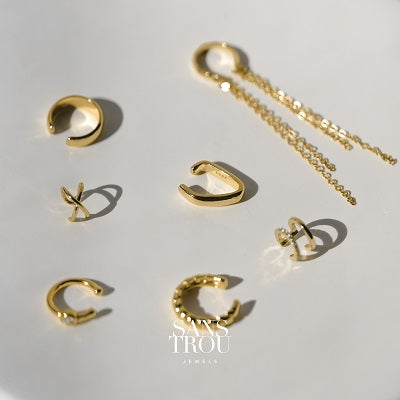Metal Allergies and Sensitive Ears
A guide to hypoallergenic materials in jewellery and why you shouldn’t give up on earrings.
Hypersensitivity to metals can affect as many as 10-15% of the global population. Itchy skin, redness, dry patches, it’s a frustrating reality for many and from something so seemingly harmless.
If this sounds familiar, you can probably relate to the disappointment of having to go without earrings. But what if we told you there is a solution that could change everything?
Our guide will outline everything you need to know about metal allergies, help you identify hypoallergenic materials, and explore earring solutions perfect for sensitive ears.

Understanding Metal Allergies
It’s important to note that the below content has not been written by medical professionals. We aren’t here to diagnose or treat - simply to provide some helpful information and tips based on our expertise. If you have any concerns about metal allergies or skin conditions, please consult a healthcare professional.
When discussing metal allergies, one of the most common conditions is allergic contact dermatitis. This occurs when your skin reacts to contact with a specific metal, even if it's harmless to others.
Symptoms can manifest as redness, itching, dry patches, or even blisters, appearing immediately or after prolonged wear, and can last for weeks. The discomfort and frustration are all too common.
The most common culprit is nickel, often used in jewellery for its versatility and low cost. Other metals that can cause reactions include cobalt and chromium. While rare, some people can even react to alloys in lower-karat gold.
The Solution: Modern Clip-On Earrings
So you have a metal allergy, now what? Many may say: “just don’t wear earrings”, but we’re not giving up that easily.
When you think of clip-ons, you might think of those chunky, painful, metal clips. Not much of a solution are they? We want to reframe your thinking, and introduce you to modern clip-ons. They have all the benefits of regular earrings, without the itchiness, redness or pain.

Well designed clip-ons should allow for little to no metal contact to the skin. Some pieces, like ear cuffs, do touch the skin, so it is still vital here to check the materials your jewellery is made of.
While the benefits of making the switch to clip-on earrings start with reduced skin contact, they don’t end there. Clip-ons allow for earrings to go where piercings can’t. Add an ear cuff or a second lobe earrings one day and take it off the next. No healing time or aftercare required. They’re modern and stylish without the fear of infection or ripped lobes. The benefits really do speak for themselves.
The Heroes of Hypoallergenic Materials
You can never be too safe when metal is close to the skin so it’s still vital to consider what your clip-ons are made from. Also note that the term hypoallergenic means ‘low risk of causing an allergic reaction’ not no risk. Here’s a run down:
925 Sterling Silver:
-
The standard for high quality jewellery, sterling silver is made from 92.5% pure silver and 7.5% copper.
-
It is generally considered hypoallergenic and suitable for nickel or other allergies.
-
See if your piece is genuine sterling silver by looking for a ‘925’ stamp.
Stainless Steel:
-
Stainless steel has no specific makeup, but rather is a blend of many types of metals like iron and chromium.
-
This material is often considered hypoallergenic due to its minimal levels of irritating metals like nickel. A level which many are able to withstand.
-
Look into surgical-grade stainless steel if you're particularly sensitive!
Gold Plating and other forms of gold:
-
Unless you have a (rare) allergy, gold can be a great option.
-
Keep in mind that there will be a base metal underneath the plating, so if it begins to wear away, double check the composition of the metal underneath.
-
Higher quality clip-ons utilise hypoallergenic base metals like sterling silver or stainless steel. You want to avoid ones that are vague or worse, don’t state the materials used.
Hypoallergenic Resin:
-
A form of plastic that is used in clip-ons to reduce the skin contact of metals.
-
The flexibility of resin clips ensures a comfortable, secure fit that's gentle on your ears, without the unnecessarily painful pressure.
-
Resin clips come in many forms to suit as many ears as possible.
-
Above all, their transparent finish looks discreet and subtle on the ear!

Again, if you are unsure or have a reaction to any of the above materials, please remove them immediately and seek the advice of a professional.
What to Look for When Buying Hypoallergenic Clip-Ons
By now, you should have enough information to confidently start wearing earrings without the side effects. Here are a few extra tips to consider before we leave you to explore the world of clip-ons:
-
Carefully read material descriptions: Always check what your pieces are made of before wearing. If you aren’t sure, reach out to the brand.
-
Read reviews: You'll often find others with metal allergies chiming in with their experiences, helping to guide your choices.
-
Check wording: Hypoallergenic’ isn't a regulated term and simply indicates the manufacturer's intention to use fewer common irritants. ‘Nickel-free’ (or any other metal specific phrasing) is a much more specific and reliable claim to look for if you have metal sensitivities.
-
Buy from reputable sellers: It is vital to purchase your pieces from trustworthy brands and sellers who have your best interests in mind.
Ready to explore some options?
Navigating earring options with metal allergies and sensitivities means knowing what works for you and what to avoid. It can get tricky and maybe even a little frustrating, but here's the exciting part: sensitive ears or not having piercings absolutely do not have to mean missing out on expressing your unique style!
Discover a world of beautiful, comfortable, and fashionable options designed just for you.



